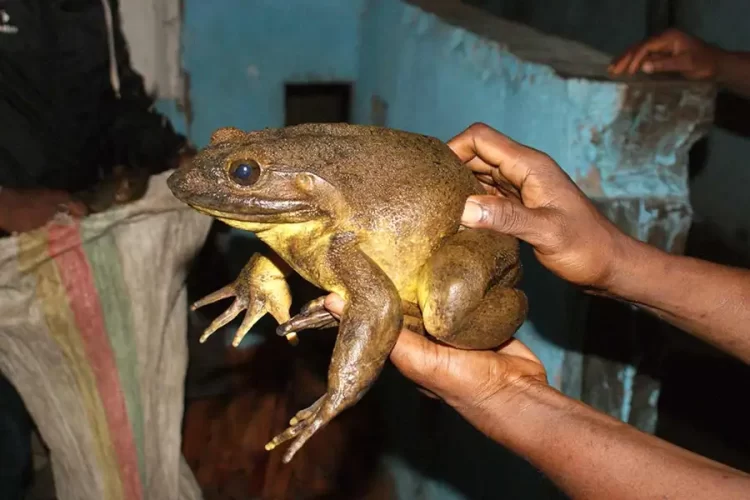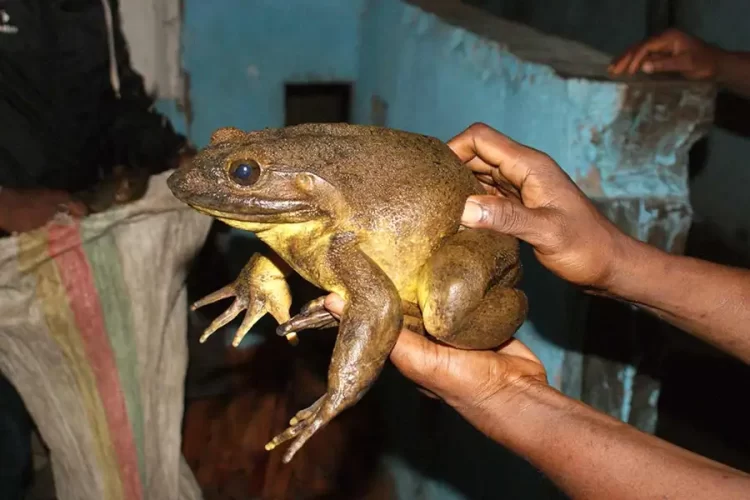The Goliath Frog, the largest living frog on Earth, is facing extinction after a 50% decline in population size in the last three generations, mainly due to human activity.
The Goliath Frog certainly lives up to its name. Reaching up to 13 inches long (32 cm) from snout to vent, and weighing up to 7.2 lb (3.25 kg), it is by far the world’s largest frog. However, it has a contrastingly tiny habitat range in Africa’s Cameroon and Equatorial Guinea, which makes it particularly vulnerable to human-related habitat destruction. They are skittish creatures that tend to avoid humans as much as possible, but increasingly sophisticated traps and habitat destruction have caused a massive decrease in the number of Goliath frogs, and experts warn that if things don’t change soon, this impressive creature will become extinct.

Photo: Mark-Oliver Rödel of the Berlin Museum for Natural History in Germany
“At the peak hunting season, which falls between November and April, at least 20,000 Goliath frogs are hunted,” Sancho, the executive director of conservation NGO Voice of Nature, told Fair Planet, adding that demand for the amphibian is insane, as it is considered a delicacy in some communities in southwestern Cameroon. One Goliath frog can sell for up to $15, which is quite a pretty sum in countries like Cameroon and Equatorial Guinea.
For years, Cameroon’s Government ignored the decimation of Goliath frogs, but eventually, lobbying by conservation NGOs led to the creation of the Muanenguba Herpeto-ornithological Sanctuary, a safe haven for several endangered species, including this spectacular frog. Poachers looking to fill their pockets often venture into the sanctuary, but conservation activists hope that the Government will soon start sending ‘eco-guards’ to defend the animals.
Despite its plight at the hands of humans, mainly through hunting and deforestation, the Goliath frog remains one of the most elusive animal species on Earth. A team of scientists hoping to observe the eating habits of Goliath tadpoles in the event of needing to one day breed the species in captivity to ensure its survival reported that frogs would leap into the Mpoula River in western Cameroon at the slightest sound of humans approaching.
Interestingly, while trying to observe Goliath grogs in their habitat, scientists may have discovered why they evolved to grow as large as they do compared to most other frog species. Although they didn’t get to see too many adult specimens, researchers did come across multiple spawning pools, which didn’t look like any other frog breeding sites. Out of three types of structures observed, one of them appeared to have been built by the frogs using their size and large muscles.
In a 2019 study, researchers reported that Goliath frogs dug holes into the gravel riverbanks and encircle them with larger stones and rocks, essentially creating small ponds that provided a barrier against predators like fish and shrimp, but also prevented fluctuating water levels. Interestingly, some of these ponds were built with large, heavy rocks, some weighing up to 4.4 pounds or more than double the Goliath frog’s weight.
“The fact that we’ve only just discovered these behaviors shows how little we know about even some of the most spectacular creatures on our planet,” study co-author Mark-Oliver Rödel told Popular Science.
Scientists estimate that Goliath frogs have been around for 250 million years, but we still know so little about them. And, sadly, if nothing is done to protect their habitat and limit hunting, they could become extinct in just a few years.













